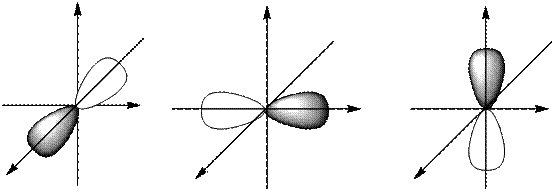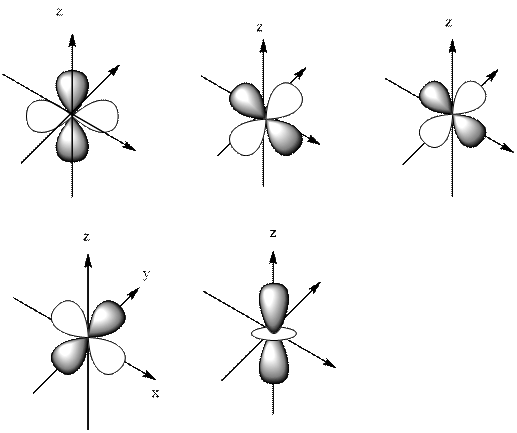
EBK CHEMICAL PRINCIPLES
8th Edition
ISBN: 9781305856745
Author: DECOSTE
Publisher: CENGAGE LEARNING - CONSIGNMENT
expand_more
expand_more
format_list_bulleted
Question
Chapter 12, Problem 137AE
Interpretation Introduction
Interpretation:The sign
Concept introduction:In an attempt to define
The pictorial representation of three degenerate

The pictorial representationsof five degenerate

Here the shaded love represents
Expert Solution & Answer
Want to see the full answer?
Check out a sample textbook solution
Students have asked these similar questions
Part II. Identify whether the two protons in blue are homotopic, enantiopic, diasteriotopic, or heterotopic.
a)
HO
b)
Bri
H
HH
c)
d)
H
H H Br
0
None
Choose the option that is decreasing from biggest to smallest.
Group of answer choices:
100 m, 10000 mm, 100 cm, 100000 um, 10000000 nm
10000000 nm, 100000 um, 100 cm, 10000 mm, 100 m
10000000 nm, 100000 um, 10000 mm, 100 cm, 100 m
100 m, 100 cm, 10000 mm, 100000 um, 10000000 nm
Chapter 12 Solutions
EBK CHEMICAL PRINCIPLES
Ch. 12 - Prob. 1DQCh. 12 - Prob. 2DQCh. 12 - Prob. 3DQCh. 12 - The first four ionization energies for elements X...Ch. 12 - Prob. 5DQCh. 12 - Prob. 6DQCh. 12 - Prob. 7DQCh. 12 - Prob. 8DQCh. 12 - Prob. 9DQCh. 12 - Prob. 10DQ
Ch. 12 - Prob. 11DQCh. 12 - Prob. 12DQCh. 12 - Prob. 13DQCh. 12 - Prob. 14DQCh. 12 - Prob. 15DQCh. 12 - Prob. 16DQCh. 12 - Prob. 17DQCh. 12 - Is the following statement true or false: The...Ch. 12 - Which is higher in energy: the 2s or 2p orbital in...Ch. 12 - Prove mathematically that it is more energetically...Ch. 12 - Microwave radiation has a wavelength on the order...Ch. 12 - Consider the following waves representing...Ch. 12 - Prob. 23ECh. 12 - Human color vision is “produced” by the nervous...Ch. 12 - One type of electromagnetic radiation has a...Ch. 12 - Carbon absorbs energy at a wavelength of 150. nm....Ch. 12 - Prob. 27ECh. 12 - X rays have wavelengths on the order of 110-10m...Ch. 12 - The work function of an element is the energy...Ch. 12 - Ionization energy is the energy required to remove...Ch. 12 - It takes 208.4 kJ of energy to remove 1 mole of...Ch. 12 - What experimental evidence supports the quantum...Ch. 12 - Explain the photoelectric effect.Ch. 12 - Calculate the de Broglie wavelength for each of...Ch. 12 - Neutron diffraction is used in determining the...Ch. 12 - Calculate the velocities of electrons with de...Ch. 12 - An atom of a particular element is traveling at 1%...Ch. 12 - Characterize the Bohr model of the atom. In the...Ch. 12 - Prob. 39ECh. 12 - Consider only the transitions involving the first...Ch. 12 - Calculate the longest and shortest wavelengths of...Ch. 12 - Prob. 42ECh. 12 - Assume that a hydrogen atom’s electron has been...Ch. 12 - What is the maximum wavelength of light capable...Ch. 12 - An electron is excited from the ground state to...Ch. 12 - Does a photon of visible light (=400700nm)...Ch. 12 - An excited hydrogen atom emits light with a...Ch. 12 - An excited hydrogen atom with an electron in the n...Ch. 12 - Consider an electron for a hydrogen atom in an...Ch. 12 - Prob. 50ECh. 12 - One of the emission spectral lines for Be3+ has a...Ch. 12 - The Heisenberg uncertainty principle can be...Ch. 12 - Using the Heisenberg uncertainty principle,...Ch. 12 - We can represent both probability and radial...Ch. 12 - Prob. 55ECh. 12 - Calculate the wavelength of the electromagnetic...Ch. 12 - An electron in a one-dimensional box requires a...Ch. 12 - An electron in a 10.0-nm one-dimensional box is...Ch. 12 - Prob. 59ECh. 12 - What is the total probability of finding a...Ch. 12 - Which has the lowest (ground-state) energy, an...Ch. 12 - What are quantum numbers? What information do...Ch. 12 - How do 2p orbitals differ from each other? How do...Ch. 12 - Identify each of the following orbitals, and...Ch. 12 - Which of the following orbital designations are...Ch. 12 - Prob. 66ECh. 12 - The following sets of quantum numbers are not...Ch. 12 - How many orbitals can have the designation 5p,...Ch. 12 - How many electrons in an atom can have the...Ch. 12 - Prob. 70ECh. 12 - Prob. 71ECh. 12 - From the diagrams of 2p and 3p orbitals in Fig....Ch. 12 - Prob. 73ECh. 12 - Prob. 74ECh. 12 - Total radial probability distributions for the...Ch. 12 - The relative orbital levels for the hydrogen atom...Ch. 12 - What is the difference between core electrons and...Ch. 12 - Prob. 78ECh. 12 - Prob. 79ECh. 12 - The elements of Si, Ga, As, Ge, Al, Cd, S, and Se...Ch. 12 - Write the expected electron configurations for the...Ch. 12 - Write the expected electron configurations for...Ch. 12 - Prob. 83ECh. 12 - Using Fig. 12.29, list elements (ignore the...Ch. 12 - Prob. 85ECh. 12 - Prob. 86ECh. 12 - Prob. 87ECh. 12 - Prob. 88ECh. 12 - Prob. 89ECh. 12 - Prob. 90ECh. 12 - Prob. 91ECh. 12 - Prob. 92ECh. 12 - Prob. 93ECh. 12 - Prob. 94ECh. 12 - Prob. 95ECh. 12 - A certain oxygen atom has the electron...Ch. 12 - Prob. 97ECh. 12 - Prob. 98ECh. 12 - Prob. 99ECh. 12 - Explain why the first ionization energy tends to...Ch. 12 - Prob. 101ECh. 12 - The radius trend and the ionization energy trend...Ch. 12 - Prob. 103ECh. 12 - Prob. 104ECh. 12 - In each of the following sets, which atom or ion...Ch. 12 - Prob. 106ECh. 12 - Prob. 107ECh. 12 - Prob. 108ECh. 12 - Prob. 109ECh. 12 - Prob. 110ECh. 12 - Prob. 111ECh. 12 - Consider the following ionization energies for...Ch. 12 - Prob. 113ECh. 12 - Prob. 114ECh. 12 - Prob. 115ECh. 12 - Prob. 116ECh. 12 - Prob. 117ECh. 12 - Prob. 118ECh. 12 - Prob. 119ECh. 12 - Prob. 120ECh. 12 - Prob. 121ECh. 12 - Prob. 122ECh. 12 - Prob. 123ECh. 12 - Prob. 124ECh. 12 - Prob. 125ECh. 12 - Prob. 126ECh. 12 - Prob. 127ECh. 12 - Prob. 128AECh. 12 - Prob. 129AECh. 12 - Prob. 130AECh. 12 - Prob. 131AECh. 12 - Prob. 132AECh. 12 - Prob. 133AECh. 12 - Prob. 134AECh. 12 - Prob. 135AECh. 12 - Prob. 136AECh. 12 - Prob. 137AECh. 12 - Prob. 138AECh. 12 - Prob. 139AECh. 12 - An unknown element is a nonmetal and has a...Ch. 12 - Prob. 141AECh. 12 - Using data from this chapter, calculate the change...Ch. 12 - Answer the following questions, assuming that ms...Ch. 12 - Prob. 144AECh. 12 - Prob. 145AECh. 12 - Prob. 146AECh. 12 - The figure below represents part of the emission...Ch. 12 - Prob. 148AECh. 12 - Prob. 149AECh. 12 - Prob. 150AECh. 12 - Prob. 151AECh. 12 - Prob. 152AECh. 12 - Prob. 153AECh. 12 - Identify the following three elements. a. The...Ch. 12 - Prob. 155AECh. 12 - Prob. 156AECh. 12 - Prob. 157AECh. 12 - Prob. 158CPCh. 12 - The ground state ionization energy for the one...Ch. 12 - When the excited electron in a hydrogen atom falls...Ch. 12 - Prob. 161CPCh. 12 - The following numbers are the ratios of second...Ch. 12 - Prob. 163CPCh. 12 - Prob. 164CPCh. 12 - Prob. 165CPCh. 12 - Prob. 166CPCh. 12 - The ionization energy for a 1s electron in a...Ch. 12 - Without looking at data in the text, sketch a...
Knowledge Booster
Learn more about
Need a deep-dive on the concept behind this application? Look no further. Learn more about this topic, chemistry and related others by exploring similar questions and additional content below.Similar questions
- Q1. (a) Draw equations for homolytic and heterolytic cleavages of the N-H bond in NH3. Use curved arrows to show the electron movement. (b) Draw equations for homolytic and heterolytic cleavages of the N-H bond in NH4*. Use curved arrows to show the electron movement.arrow_forwardWhich is NOT the typical size of a bacteria? 1000 nm 0.001 mm 0.01 mm 1 umarrow_forwardNonearrow_forward
- Show work. don't give Ai generated solutionarrow_forwardPart II. count the expected number of signals in the 1H-NMR spectrum of these compounds HO 0 одев * Cl -cl "D"arrow_forwardPart I. Create a splitting tree diagram to predict the multiplet pattern of proton Hb in the compound below: 3 (Assume that "Jab >>> ³JbC) Ha Hb He он Ha NH2 Ha HCarrow_forward
- SH 0 iq noitzouDarrow_forwardNonearrow_forward+ HCl →? Draw the molecule on the canvas by choosing buttons from the Tools (for bonas), Atoms and Advanced Template toolbars. The single bond is active by default. + M C + H± 2D EXP. CONT. K ? L 1 H₁₂C [1] A HCN O S CH3 CH 3 CI Br HC H₂ CH CH CH3 - P Farrow_forward
arrow_back_ios
SEE MORE QUESTIONS
arrow_forward_ios
Recommended textbooks for you
 ChemistryChemistryISBN:9781305957404Author:Steven S. Zumdahl, Susan A. Zumdahl, Donald J. DeCostePublisher:Cengage Learning
ChemistryChemistryISBN:9781305957404Author:Steven S. Zumdahl, Susan A. Zumdahl, Donald J. DeCostePublisher:Cengage Learning Chemistry: An Atoms First ApproachChemistryISBN:9781305079243Author:Steven S. Zumdahl, Susan A. ZumdahlPublisher:Cengage Learning
Chemistry: An Atoms First ApproachChemistryISBN:9781305079243Author:Steven S. Zumdahl, Susan A. ZumdahlPublisher:Cengage Learning
 Chemistry: The Molecular ScienceChemistryISBN:9781285199047Author:John W. Moore, Conrad L. StanitskiPublisher:Cengage Learning
Chemistry: The Molecular ScienceChemistryISBN:9781285199047Author:John W. Moore, Conrad L. StanitskiPublisher:Cengage Learning Principles of Modern ChemistryChemistryISBN:9781305079113Author:David W. Oxtoby, H. Pat Gillis, Laurie J. ButlerPublisher:Cengage Learning
Principles of Modern ChemistryChemistryISBN:9781305079113Author:David W. Oxtoby, H. Pat Gillis, Laurie J. ButlerPublisher:Cengage Learning Physical ChemistryChemistryISBN:9781133958437Author:Ball, David W. (david Warren), BAER, TomasPublisher:Wadsworth Cengage Learning,
Physical ChemistryChemistryISBN:9781133958437Author:Ball, David W. (david Warren), BAER, TomasPublisher:Wadsworth Cengage Learning,

Chemistry
Chemistry
ISBN:9781305957404
Author:Steven S. Zumdahl, Susan A. Zumdahl, Donald J. DeCoste
Publisher:Cengage Learning

Chemistry: An Atoms First Approach
Chemistry
ISBN:9781305079243
Author:Steven S. Zumdahl, Susan A. Zumdahl
Publisher:Cengage Learning


Chemistry: The Molecular Science
Chemistry
ISBN:9781285199047
Author:John W. Moore, Conrad L. Stanitski
Publisher:Cengage Learning

Principles of Modern Chemistry
Chemistry
ISBN:9781305079113
Author:David W. Oxtoby, H. Pat Gillis, Laurie J. Butler
Publisher:Cengage Learning

Physical Chemistry
Chemistry
ISBN:9781133958437
Author:Ball, David W. (david Warren), BAER, Tomas
Publisher:Wadsworth Cengage Learning,
Quantum Numbers, Atomic Orbitals, and Electron Configurations; Author: Professor Dave Explains;https://www.youtube.com/watch?v=Aoi4j8es4gQ;License: Standard YouTube License, CC-BY
QUANTUM MECHANICAL MODEL/Atomic Structure-21E; Author: H to O Chemistry;https://www.youtube.com/watch?v=mYHNUy5hPQE;License: Standard YouTube License, CC-BY